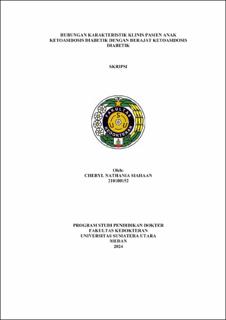| dc.description.abstract | Background. Diabetic ketoacidosis (DKA) is one of the most serious acute
complications in children with diabetes mellitus.Understanding the relationship
between clinical characteristics and degree of DKA is important for risk
stratification, prognosis prediction and optimization of patient management.
Objective. To analyze the relationship between clinical characteristics and the
degree of DKA in pediatric patients at Adam Malik Hospital Medan. Methods. A
retrospective cross-sectional study was conducted on 26 pediatric DKA patients.
Data analysis employed Kruskal-Wallis test and Spearman correlation test with a
significance level of p<0.05.Results and Discussion. Most patients were aged >10-
18 years and suffered from type 1 DM. The highest degree of DKA was severe
(50%) followed by moderate (30,8%) and mild (19,2%).The most common initial
symptoms were polyuria, polydipsia and polyphagia (69,2%). The most common
triggering factor was non-compliance with treatment (42,3%). The most common
complication was acute kidney injury (36%). There was a significant relationship
between type of DM (p=0,021),C-peptide levels (p=0.031) HbA1c levels (p<0.001)
and chloride levels (p=0.045) with the degree of DKA.However, there was no
relationship between gender, nutritional status, family history of DM, triggering
factors, sodium, potassium, and calcium levels with the degree of DKA. C-peptide
levels negatively correlated with the degree of DKA (r=0,506) while HbA1c levels
(r=0.467) and chloride levels (r=0.401) positively correlated with the degree of
DKA. Conclusion. There was a relationship between the type of DM, HbA1c levels,
C-peptide levels, and chloride levels with the degree of DKA. A negative correlation
was found between C-peptide levels and the degree of DKA, whereas HbA1c levels
and chloride levels showed positive correlation with the degree of DKA. | en_US |


